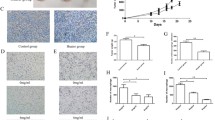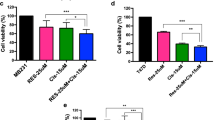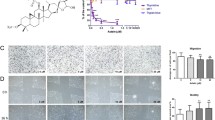Abstract
Sesamin is a sesame component with antihypertensive and antioxidative activities and has recently aroused much interest in studying its potential anticancer application. Macrophage is one of the infiltrating inflammatory cells in solid tumor and may promote tumor progression via enhancement of tumor angiogenesis. In this study, we investigated whether sesamin inhibited macrophage-enhanced proangiogenic activity of breast cancer cell lines MCF-7 and MDA-MB-231. Using vascular endothelial cell capillary tube and network formation assays, both breast cancer cell lines exhibited elevated proangiogenic activities after coculture with macrophages or pretreatment with macrophage-conditioned medium. This elevation of proangiogenic activity was drastically suppressed by sesamin. Vascular endothelial growth factor (VEGF) and matrix metalloproteinase-9 (MMP-9) induced by macrophages in both cell lines were also inhibited by sesamin. Nuclear levels of HIF-1α and NF-κB, important transcription factors for VEGF and MMP-9 expression, respectively, were obviously reduced by sesamin. VEGF induction by macrophage in MCF-7 cells was shown to be via ERK, JNK, phosphatidylinositol 3-kinase, and NF-κB-mediated pathways. These signaling molecules and additional p38MAPK were also involved in macrophage-induced MMP-9 expression. Despite such diverse pathways were induced by macrophage, only Akt and p38MAPK activities were potently inhibited by sesamin. Expression of interleukin (IL)-6, IL-8, and tumor necrosis factor-α were substantially increased and involved in macrophage-induced VEGF and MMP-9 mRNA expression in MCF-7 cells. Sesamin effectively inhibited the expression of these cytokines to avoid the reinforced induction of VEGF and MMP-9. In conclusion, sesamin potently inhibited macrophage-enhanced proangiogenic activity of breast cancer cells via inhibition of VEGF and MMP-9 induction.









Similar content being viewed by others
Abbreviations
- TAM:
-
Tumor-associated macrophage
- VEGF:
-
Vascular endothelial growth factor
- FGF:
-
Fibroblast growth factor
- IL:
-
Interleukin
- TNF-α:
-
Tumor necrosis factor-α
- TGF-β:
-
Transforming growth factor-β
- MMP:
-
Matrix metalloproteinases
- MϕCM:
-
Macrophage-conditioned medium
- MCFCM:
-
MCF-7 cell-conditioned medium
- MDACM:
-
MDA-MB-231 cell-conditioned medium
- PI3-K:
-
Phosphatidylinositol 3-kinase
- HUVECs:
-
Human umbilical vein endothelial cells
References
Balkwill, F. 2004. Cancer and the chemokine network. Nature Reviews. Cancer 4: 540–550.
van Kempen, L.C., K.E. de Visser, and L.M. Coussens. 2006. Inflammation, proteases and cancer. European Journal of Cancer 42: 728–734.
Bingle, L., N.J. Brown, and C.E. Lewis. 2002. The role of tumour-associated macrophages in tumour progression: Implications for new anticancer therapies. The Journal of Pathology 196: 254–265.
Lee, C.C., K.J. Liu, and T.S. Huang. 2006. Tumor-associated macrophage: Its role in tumor angiogenesis. Journal of Cancer Molecules 2: 135–140.
Lewis, C., and C. Murdoch. 2005. Macrophage responses to hypoxia: Implications for tumor progression and anti-cancer therapies. The American Journal of Pathology 167: 627–635.
Vicioso, L., F.J. Gonzalez, M. Alvarez, N. Ribelles, M. Molina, A. Marquez, L. Perez, A. Matilla, and E. Alba. 2006. Elevated serum levels of vascular endothelial growth factor are associated with tumor-associated macrophages in primary breast cancer. American Journal of Clinical Pathology 125: 111–118.
Leek, R.D., and A.L. Harris. 2002. Tumor-associated macrophages in breast cancer. Journal of Mammary Gland Biology and Neoplasia 7: 177–189.
Lee, A.H., L.C. Happerfield, L.G. Bobrow, and R.R. Millis. 1997. Angiogenesis and inflammation in invasive carcinoma of the breast. Journal of Clinical Pathology 50: 669–673.
Goede, V., L. Brogelli, M. Ziche, and H.G. Augustin. 1999. Induction of inflammatory angiogenesis by monocyte chemoattractant protein-1. International Journal of Cancer 82: 765–770.
Sunderkotter, C., M. Goebeler, K. Schulze-Osthoff, R. Bhardwaj, and C. Sorg. 1991. Macrophage-derived angiogenesis factors. Pharmacology & Therapeutics 51: 195–216.
Condeelis, J., and J.W. Pollard. 2006. Macrophages: Obligate partners for tumor cell migration, invasion, and metastasis. Cell 124: 263–266.
Lewis, C.E., and J.W. Pollard. 2006. Distinct role of macrophages in different tumor microenvironments. Cancer Research 66: 605–612.
Pollard, J.W. 2004. Tumour-educated macrophages promote tumour progression and metastasis. Nature Reviews. Cancer 4: 71–78.
Lee, C.C., K.J. Liu, L.L. Chen, Y.C. Wu, and T.S. Huang. 2006. Tumor necrosis factor-α, interleukin-8 and interleukin-6 are involved in vascular endothelial cell capillary tube and network formation induced by tumor-associated macrophages. Journal of Cancer Molecules 2: 155–160.
Lee, C.C., P.R. Chen, S. Lin, S.C. Tsai, B.W. Wang, W.W. Chen, et al. 2004. Sesamin induces nitric oxide and decreases endothelin-1 production in HUVECs: Possible implications for its antihypertensive effect. Journal of Hypertension 22: 2329–2338.
Nakano, D., D. Kurumazuka, Y. Nagai, A. Nishiyama, Y. Kiso, and Y. Matsumura. 2008. Dietary sesamin suppresses aortic NADPH oxidase in DOCA salt hypertensive rats. Clinical and Experimental Pharmacology & Physiology 35: 324–326.
Miyake, Y., S. Fukumoto, M. Okada, K. Sakaida, Y. Nakamura, and T. Osawa. 2005. Antioxidative catechol lignans converted from sesamin and sesaminol triglucoside by culturing with Aspergillus. Journal of Agricultural and Food Chemistry 53: 22–27.
Nakano, D., C.J. Kwak, K. Fujii, K. Ikemura, A. Satake, M. Ohkita, et al. 2006. Sesamin metabolites induce an endothelial nitric oxide-dependent vasorelaxation through their antioxidative property-independent mechanisms: Possible involvement of the metabolites in the antihypertensive effect of sesamin. The Journal of Pharmacology and Experimental Therapeutics 318: 328–335.
Yokota, T., Y. Matsuzaki, M. Koyama, T. Hitomi, M. Kawanaka, M. Enoki-Konishi, et al. 2007. Sesamin, a lignan of sesame, down-regulates cyclin D1 protein expression in human tumor cells. Cancer Science 98: 1447–1453.
Tsai, S.C., Y.C. Liu, C.P. Li, T.S. Huang, and C.C. Lee. 2006. Sesamin inhibits vascular endothelial cell growth and angiogenic activity of lung adenocarcinoma cells. Journal of Cancer Molecules 2: 199–205.
Cutolo, M., G. Carruba, B. Villaggio, D.A. Coviello, J.M. Dayer, I. Campisi, et al. 2001. Phorbol diester 12-O-tetradecanoylphorbol 13-acetate (TPA) up-regulates the expression of estrogen receptors in human THP-1 leukemia cells. Journal of Cellular Biochemistry 83: 390–400.
Hawinkels, L.J., K. Zuidwijk, H.W. Verspaget, E.S. de Jonge-Muller, W. van Duijn, V. Ferreira, et al. 2008. VEGF release by MMP-9 mediated heparan sulphate cleavage induces colorectal cancer angiogenesis. European Journal of Cancer 44: 1904–1913.
Sica, A., T. Schioppa, A. Mantovani, and P. Allavena. 2006. Tumour-associated macrophages are a distinct M2 polarised population promoting tumour progression: Potential targets of anti-cancer therapy. European Journal of Cancer 42: 717–727.
Sica, A., P. Allavena, and A. Mantovani. 2008. Cancer related inflammation: The macrophage connection. Cancer Letters 267: 204–215.
Sica, A., L. Rubino, A. Mancino, P. Larghi, C. Porta, M. Rimoldi, et al. 2007. Targeting tumour-associated macrophages. Expert Opinion on Therapeutic Targets 11: 1219–1229.
Toi, M., S. Hoshina, T. Takayanagi, and T. Tominaga. 1994. Association of vascular endothelial growth factor expression with tumor angiogenesis and with early relapse in primary breast cancer. Japanese Journal of Cancer Research 85: 1045–1049.
Leek, R.D., R.J. Landers, A.L. Harris, and C.E. Lewis. 1999. Necrosis correlates with high vascular density and focal macrophage infiltration in invasive carcinoma of the breast. British Journal of Cancer 79: 991–995.
Tsutsui, S., K. Yasuda, K. Suzuki, K. Tahara, H. Higashi, and S. Era. 2005. Macrophage infiltration and its prognostic implications in breast cancer: The relationship with VEGF expression and microvessel density. Oncology Reports 14: 425–431.
Murdoch, C., A. Giannoudis, and C.E. Lewis. 2004. Mechanisms regulating the recruitment of macrophages into hypoxic areas of tumors and other ischemic tissues. Blood 104: 2224–2234.
Giraudo, E., M. Inoue, and D. Hanahan. 2004. An amino-bisphosphonate targets MMP-9-expressing macrophages and angiogenesis to impair cervical carcinogenesis. The Journal of Clinical Investigation 114: 623–633.
Wegiel, B., A. Bjartell, Z. Culig, and J.L. Persson. 2008. Interleukin-6 activates PI3K/Akt pathway and regulates cyclin A1 to promote prostate cancer cell survival. International Journal of Cancer 122: 1521–1529.
Knall, C., G.S. Worthen, and G.L. Johnson. 1997. Interleukin 8-stimulated phosphatidylinositol-3-kinase activity regulates the migration of human neutrophils independent of extracellular signal-regulated kinase and p38 mitogen-activated protein kinases. Proceedings of the National Academy of Sciences of the United States of America 94: 3052–3057.
Hanna, A.N., E.Y. Chan, J. Xu, J.C. Stone, and D.N. Brindley. 1999. A novel pathway for tumor necrosis factor-alpha and ceramide signaling involving sequential activation of tyrosine kinase, p21(ras), and phosphatidylinositol 3-kinase. The Journal of Biological Chemistry 274: 12722–12729.
Kazi, A.A., K.H. Molitoris, and R.D. Koos. 2009. Estrogen rapidly activates the PI3K/AKT pathway and hypoxia-inducible factor 1 and induces vascular endothelial growth factor A expression in luminal epithelial cells of the rat uterus. Biology of Reproduction 81: 378–387.
Ozes, O.N., L.D. Mayo, J.A. Gustin, S.R. Pfeffer, L.M. Pfeffer, and D.B. Donner. 1999. NF-κB activation by tumour necrosis factor requires the Akt serine-threonine kinase. Nature 401: 82–85.
Srivastava, A.K., X. Qin, N. Wedhas, M. Arnush, T.A. Linkhart, R.B. Chad-wick, et al. 2007. Tumor necrosis factor-alpha augments matrix metalloproteinase-9 production in skeletal muscle cells through the activation of transforming growth factor-beta-activated kinase 1 (TAK1)-dependent signaling pathway. The Journal of Biological Chemistry 282: 35113–35124.
Martin, P., and S.J. Leibovich. 2005. Inflammatory cells during wound repair: The good, the bad and the ugly. Trends in Cell Biology 15: 599–607.
Acknowledgments
This work was supported by the grants CA-097-PP-13 and CA-098-PP-10 from the National Health Research Institutes, the grant NSC96-2320-B-400-007 from the National Science Council, and the grants DOH97-TD-G-111-03 and DOH99-TD-C-111-004 from the Department of Health, Taiwan, Republic of China.
Conflict of interest
There is no conflict of interest.
Author information
Authors and Affiliations
Corresponding author
Rights and permissions
About this article
Cite this article
Lee, CC., Liu, KJ., Wu, YC. et al. Sesamin Inhibits Macrophage-Induced Vascular Endothelial Growth Factor and Matrix Metalloproteinase-9 Expression and Proangiogenic Activity in Breast Cancer Cells. Inflammation 34, 209–221 (2011). https://doi.org/10.1007/s10753-010-9226-z
Published:
Issue Date:
DOI: https://doi.org/10.1007/s10753-010-9226-z




